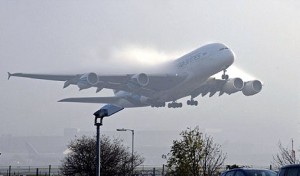Special to WorldTribune.com
By Donald Kirk, East-Asia-Intel.com
The disappearance of Malaysian Airlines 777 confronts the world with a crisis that’s never going to end.
The loss of 239 people is tragic enough, but the implications for air travel are still more frightening.
The point, which nobody had believed was possible, is that a plane can vanish in defiance of all fail-safe systems, all the most elaborate gear, both within the plane and on the ground.

That’s a reality that I don’t think any passenger, or any of the experts, had quite grasped.
In all the other great air disasters, wreckage began to surface fairly soon, if not right away.
By now it’s been nearly two weeks since MH370 was first reported overdue by two hours from the Malaysian capital of Kuala Lumpur to Beijing. Whatever turns up, whenever, the disappearance of MH370 is all the more shocking considering how safe air travel has seemed.
I’ve flown in any number of 777’s, most recently on Korean Air from Manila to Incheon. For reasons that have nothing to do with safety, I don’t particularly like the plane. I discovered, on the London-D.C. flights, the sleek pen-shaped 777 actually is slower than the jumbo 747. When it comes to safety, however, I’ve gotten so lulled into a false sense of security that I’ve drifted off to sleep before takeoff, awakening to discover we’re already over the clouds.
Flying isn’t always that reassuring. Anyone who’s accumulated inordinate numbers of miles will have had some memorable experiences. Most recently, on Philippine Airlines, the plane heaved upward as it was about to land at Bangkok. The engines went into what sounded like overdrive, and the pilot announced over the PA that he had not seen the runway quite clearly in the driving wind and rain and had “mis-approached” — a new word in my vocabulary.
After we had “gone around” again and landed, the pilot told me we had been caught in a “wind shear” — a term I had read and heard mainly on horrific Discovery Channel documentaries.
Another favorite of mine was a flight on Northwest from Hong Kong to Tokyo. The plane did a bump, after which the pilot said there’d been a fire alarm in the number four engine and he’d had to shut it down. Making an emergency landing in Taipei, we were greeted by a row of fire trucks and ambulances. We roared back to life again 30 minutes later, but the number four engine was still not working properly. As we were about to go wheels-up, the pilot aborted the takeoff.
The pilot was easy-going as he explained to me what was going on. I asked the young co-pilot beside him, what if we had kept going? His face was ashen. We would have “gone in,” he said, “into the drink.” No, we didn’t fly out again on the same plane. They put me on a Thai flight.
Those incidents, though, were not too bad since I had not known what was happening. My worst scare came after covering the first Gulf War as one of two or three U.S. correspondents to stay in Baghdad for the onslaught of U.S. missile and air strikes in early 1991. Kicked out of Baghdad by Saddam Hussein’s people, I had gone by taxi to Amman, Jordan, whizzing by an oil field as it exploded in a pyrotechnic display sparked by U.S. missiles, and then flown to Ankara for stories from the Turkish side.
Not believing I had actually been in Baghdad witnessing the U.S. strikes, a Neanderthal editor at USA Today, as incompetent as he was mean-minded, refused to pay for an international flight back to Amman. I wound up flying from Ankara to Adana in southern Turkey, from which I would go by bus through Syria to Jordan. It was the flight from hell. The small plane rocked up and down, swung wildly back and forth, swooped hard into air pockets, then pitched up again on sudden air currents. The bump and grind lasted the entire hour-long flight.
I was sure we were done for until we approached the ground, landing miraculously. Nobody said a word.
Otherwise, nothing about air travel has bothered me aside from perpetual jet lag. I’m conditioned to assuming the most severe bumps are harmless. Are not the latest model planes built for maximum safety and comfort – not counting the way they cram too many passengers in too little space? My biggest complaint has been the body searches and baggage inspections. That was before the disappearance of MH370 taught us there is no guarantee of total safety. Now we should all complain if the inspections don’t seem rigorous enough.
Columnist Donald Kirk has written two books and innumerable articles on the Philippines’ problems. He’s at kirkdon@yahoo.com.

You must be logged in to post a comment Login